The Minnesota District of the Civilian Conservation Corps (CCC) was established April 5, 1933—soon after the Emergency Conservation Work Act was passed by Congress. To qualify for CCC work, applicants had to be U.S. citizens between 17 and 23 years of age, unmarried, unemployed, physically and mentally competent, and must not have served more than 18 months in the CCC previously. Men convicted of a crime and serving a sentence, or on parole or probation were disqualified.
The central purpose of the CCC was to replenish timber resources and prevent soil erosion while giving work to millions of young men. Members of Minnesota's Greatest Generation who served in this "civilian army" made major contributions in building the Minnesota landscape we enjoy today by planting trees in our state forests, improving our state parks with new recreational facilities, building roads, and improving farmland through soil conservation. In return, these young men gained new skills, self-discipline, and renewed respect for themselves and for their country.
In the first four years of its existence the state program provided paid employment for 68,690 men in need of work. General workers received $30 per month, of which $25.00 had to be sent home to family or placed on deposit with the Army finance officer. Leaders of CCC camps drew pay of $45 per month; Assistant Leaders earned $36 per month.
The opportunity to serve in the CCC was extended to African Americans and American Indians, with enrollment limited to a percentage based on total population. Though segregated from white CCC workers in most cases, a total of 250,000 Blacks, and 84,000 American Indians served nationwide.
By 1942, when the Civilian Conservation Corps was disbanded, there had been a total of 156 CCC project camps in Minnesota, including two regular and ten mobile camps of the CCC Indian Division, with an average of 51 camps operating at any given time. 84,000 young Minnesota men had benefited from the program. A total of $84,900,000 was invested in Civilian Conservation Corps projects in Minnesota. The results included 124 million trees planted, 4,000 miles of new roads, 3,330 miles of firebreaks built, 1,635 miles of forest telephone lines strung, construction of numerous state and national park structures, and statewide soil conservation efforts.
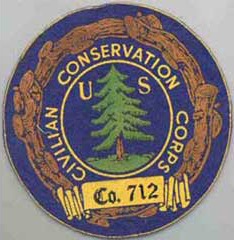
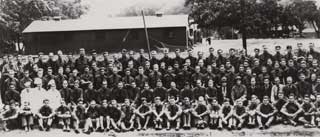
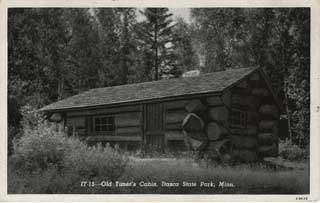
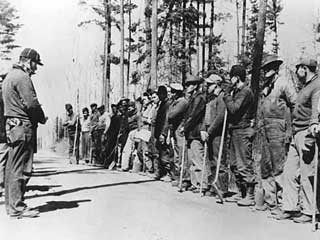
Better Men, A Better Minnesota
The $25 per month sent home by CCC members kept many families off of relief as the country struggled to get back on its feet during the Depression, but there were longer-term benefits realized by the 84,000 young Minnesotans that served in the Civilian Conservation Corps.
George Cressel looked back on his time in the CCC as a learning experience. John Buskowiak gained respect for authority and himself. Alfred E. Nelson believed the self-discipline and conservation awareness were the greatest benefits. Harley Heegard credited the program with giving young men a start in their careers. Many men made lasting friendships, reinforced over the years by camp reunions. Many believe that today's youth would profit from a similar opportunity.
The participants and their families were not the only beneficiaries. By the time the CCC program ended in June 1942, the state of Minnesota had 124 million new trees planted, 3,900 miles of new roads, 3,330 miles of firebreaks in its forests, 1,635 miles of telephone lines strung, and thousands of acres of land conserved. The legacy of the CCC lives on in the scenic beauty of our state and national forests, and in the many stone and log buildings that survive in Minnesota's state parks.
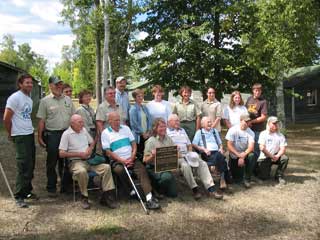
An Honest Day's Work
At a time when 11,000,000 able-bodied American workers were out of a job, the Civilian Conservation Corps offered young men an opportunity to learn new skills while doing an honest day's work.
The schedule varied from camp to camp, but most workers put in an eight-hour day, with an early start and an hour break for lunch, leaving evenings free for education and recreation. Each camp had a strict workday schedule that enrollees were required to follow.
The type of work conducted depended upon the location of each camp; enrollees assigned in northern Minnesota, like Michael T. Sanchelli, Alfred E. Nelson, and James Clark, focused on forestry projects in state and national forests. Boys in the southern part of the state concentrated on soil conservation, like John Buskowiak. Young men of the CCC planted 124,000,000 trees in Minnesota, built roads, dams and firebreaks, and saved thousands of acres of valuable farmland from unnecessary erosion.
![Film: Improvement work in the state forests by CCC's [1935?]. Loc.
no. E-37](../../../sites/default/files/mgg/artifacts/img_intro/work_film.jpg)
Leaving Home
The Civilian Conservation Corps represented many things to Minnesota's young men. Some were eager to seize the offer of work and income during hard times; some saw an opportunity to learn career skills, while others sought adventure.
Leaving home was a big first step, particularly for those who had never been away from home. Once adjusted to the daily routine of camp life, however, most men enjoyed their time with the Corps.
Raphael John Buskowiak welcomed the CCC experience, while Michael T. Sanchelli, reluctant at first, enrolled from a sense of duty to his family. Alfred E. Nelson, who joined the CCC at age 17, recalled his fear at leaving home. James Clark, a member of the Mille Lacs Band of Ojibwa, found the change easier due to time spent at Indian boarding schools.

Life in Camp
Adjusting to life in camp was a challenge for many new Civilian Conservation Corps recruits. The strict military routines and discipline of the Corps often made the transition from home more difficult. New friends, square meals, new clothing, improved job skills, and the security of a paycheck to send home helped workers to adapt.
New recruits were young men, often with little education and few skills. CCC camps provided educational opportunities to learn skills that would help them to find employment after their term of service.
Perhaps most memorable, however, were the recreational offerings at the camps. R. John Buskowiak appreciated the camp recreation halls as a quiet place to read, grab a snack, or write letters home. Alfred E. Nelson enjoyed the team sports and the opportunity to take advantage of nearby lakes and rivers for swimming and boating. C.J. Knoblauch recalled the colorful camp cook, who ruled his dining room with an iron fist. Clair T. Rollings, Educational Advisor, remembered the practical jokes played on new recruits.
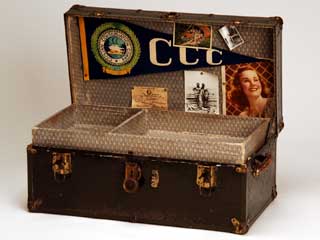
Investigate Further
Primary Sources
 Document: Conserving Social and Natural Resources.
Document: Conserving Social and Natural Resources. Map: NPS and Minnesota State Park Emergency Conservation Work.
Map: NPS and Minnesota State Park Emergency Conservation Work. Document: Handbook of Instruction for enrollees, Civilian Conservation Corps Company 3707, Camp 5-53, Two Harbors, Minn., 1939.
Document: Handbook of Instruction for enrollees, Civilian Conservation Corps Company 3707, Camp 5-53, Two Harbors, Minn., 1939.- Cressel, George; Amy K. Reiger, Interviewer, Itasca State Park Oral History Project. MNHS Oral History Collection, 1993.
- Heegard, Harley; Amy K. Reiger, Interviewer, Itasca State Park Oral History Project. MNHS Oral History Collection.
- Nelson, Alfred, E. (Irv); Stanley Johnson, Interviewer, Oral History Interview. MNHS Oral History Collection, 1976.
- Clark, James; Dr. Anthony Godfrey, Interviewer, Mille Lacs Ojibwe Social History Project, Oral History, 1992. Mille Lacs Tribal Archives, Onamia, Minn.
Articles
- Drake, Robert M. A Prideful Recollection of the Old CCC. The Minnesota Volunteer, Vol. 46, No. 2691983, p. 3-9. St. Paul, MN: Minnesota Department of Natural Resources, 1983.
- African Americans in the Civilian Conservation Corps. New Deal Network, 2003.


